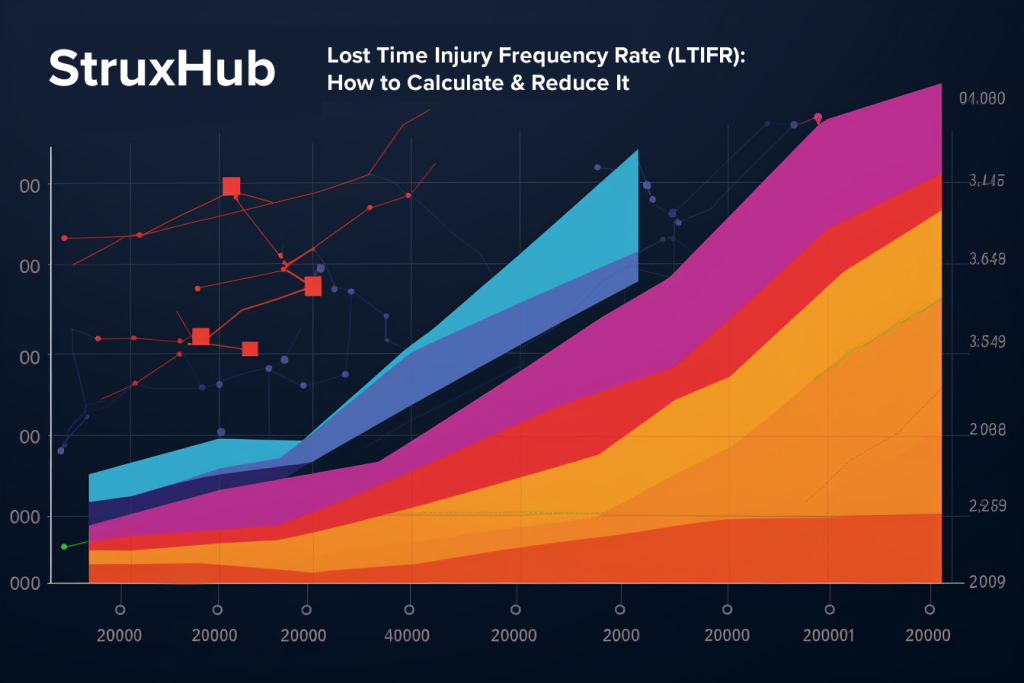Lost Time Injury Frequency Rate (LTIFR): How to Calculate & Reduce It
Table of Contents:
Construction, when viewed through a particular lens, is nothing short of a grand ballet. At first glance, it may seem all bricks and beams, concrete and chaos. But let’s dim the lights, cue the orchestra, and take a moment to truly appreciate the art of it.

The Grand Ballet of Construction
Firstly, the construction site, much like the grand stages of the Bolshoi or the Royal Opera House, is filled with its own cast of characters, each playing their vital role. It isn’t just about constructing buildings; it’s about orchestrating movements, ensuring every jump, lift, and turn (or, in our case, drill, pour, and weld) is executed flawlessly.
In this grand spectacle, cranes dance through the air as our prima ballerinas. Majestic, graceful, and precise, they command attention as they move, eliciting gasps of awe. Scaffolding, meanwhile, sets our stage, providing the framework upon which our performers—laborers, engineers, and architects—display their skills.
Yet, as in all ballets, the beauty on stage is underscored by a deep respect for discipline and safety. Every pirouette and fouetté in ballet requires not just talent but an inherent understanding of balance and coordination to prevent missteps. Similarly, for every crane hoist or brick laid in construction, there’s a deep-seated dedication to ensuring no harm befalls any member of the crew. This commitment is embodied in our meticulous attention to safety metrics, the most paramount of which is the Lost Time Injury Frequency Rate (LTIFR).
For those unfamiliar with the acronym (and fret not if you are—after all, not all of us know our adagios from our allegros), LTIFR is akin to the pulse of a ballet performance. It monitors the rhythm, ensures the pace, and most importantly, signals if and when something goes awry. In the world of construction, it offers insights into the frequency of injuries that result in lost work time, allowing managers to gauge the safety performance of a project. It’s not merely a metric; it’s a testament to a site’s dedication to the well-being of its crew.
But as essential as it is, computing the LTIFR has traditionally been as challenging as mastering the perfect grand jeté. Numbers, hours, incidents—it’s a whirlwind of data that requires careful tabulation.

StruxHub
Discover how StruxHub can revolutionize your construction management. Contact us today!
Ah, but what if we told you that there’s a way to make this intricate calculation as effortless as a seasoned ballerina making a perfect landing? Enter the age of technological marvels, where sophisticated tools await in the wings, ready to dazzle. The curtain rises on innovative platforms and software, which, with a flourish, simplify the once daunting task.
So, as we prepare to delve deeper into this intricate world of construction ballet, keep your eyes peeled for some tech-savvy tricks and tools that promise not only to enlighten but also to entertain. After all, in the grand performance of construction, every tool, every metric, and every worker plays a starring role, ensuring the show goes on—safely and spectacularly.
LTIFR: Not as Scary as it Sounds
Lost Time Injury Frequency Rate (LTIFR) is basically the ‘metronome’ of the construction safety world. It tells us the frequency of lost time injuries relative to the number of hours worked, providing an essential snapshot of a job site’s safety performance.
But before diving into the nitty-gritty, let’s clear the stage with some of our fellow safety metrics that often make guest appearances:
Total Recordable Incident Rate (TRIR): Think of this as the backstage crew – essential, often overlooked, but crucial to the show.
Incident Rate: The spotlight operator ensuring everything shines just right.
Measurements of Safety in Construction: Our beloved choreographer ensuring every move aligns perfectly.
With the cast introduced, let’s waltz through the calculations.
Dancing Through the LTIFR Calculation
Traditionally, calculating the LTIFR would involve:
LTIFR = (Number of lost time injuries x 1,000,000) / Total manhours worked
The number 1,000,000 makes the metric standardized, ensuring the rhythm stays consistent across all job sites.
But wait! Before you pull out your calculators (or perhaps an abacus for the traditionalists among us), we’ve got news.
Enter StruxHub: Your Digital Dance Partner
Ah, the modern era! A time when we can order a latte via an app and have drones capture our best construction angles. And now? Now you don’t have to manually track and calculate LTIFR or any other safety metric.
Calculating and generating health and safety reports for stakeholders just got as smooth as a waltz. How? Thanks to StruxHub, which accurately tracks all manhours for your jobsite using those trendy scannable QR codes.
The result? Easily calculated injury reports that you can flaunt not only to your internal crew but also to potential customers, who’ll be utterly wowed by your diligence. And remember, it’s not just about the numbers; it’s about the story they tell. With heightened visibility into the job’s every pirouette and plié, potential safety missteps are spotted in a jiffy, ensuring swift corrections. No more nasty surprises or unplanned solos!
Taking the Final Bow: Embracing the New Safety Rhythms
With tools like StruxHub and the Incident Rate Calculator, measuring and improving safety in construction has never felt so graceful. By embracing these innovations, we not only ensure the safety of our crew but also elevate the entire industry’s performance.
To conclude, while the world of construction might not have standing ovations or curtain calls, by prioritizing safety and embracing technology, we’re sure setting the stage for spectacular success. So, here’s to fewer injuries, more efficient reporting, and of course, a seamless dance of construction safety. Encore! Encore!
StruxHub is a construction project management software that helps you manage projects from start to finish. It offers features like task management, document management, and communication tools. StruxHub can help you save time and money, improve communication, collaboration, and decision-making.
To learn more about how StruxHub can streamline your construction management processes, request a demo today. By completing our form, you’ll hear from our team soon to discuss how StruxHub can help you:
- Schedule construction material deliveries with your trades
- Coordinate construction site resources and on-site logistics
- Digitize work permits and inspection forms
- Communicate and track P6 and Excel schedules
- Broadcast announcements to all construction workers
Don’t miss out on the opportunity to optimize your construction management processes with StruxHub. Sign up for a free demo today.



